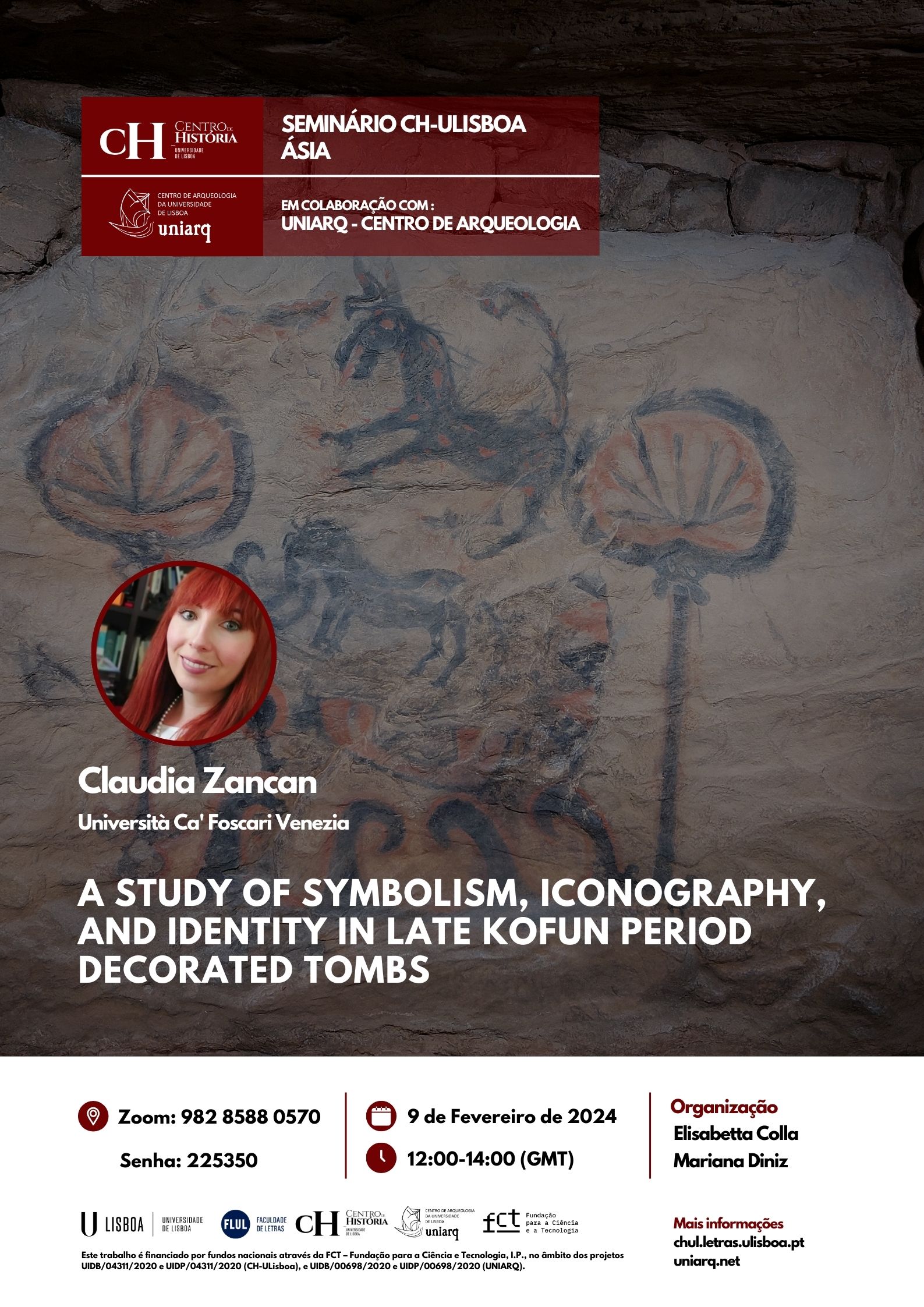Semnário CH-ULisboa Ásia
A Study of Symbolism, Iconography, and Identity in Late Kofun Period Decorated Tombs
9 de Fevereiro de 2024
12:00 GMT | Online
Zoom | https://videoconf-colibri.zoom.us/j/98285880570?pwd=ZHVLNXRtNm1CSU1ZTjdCTlZYSGgzZz09
Organização | Elisabetta Colla (FLUL/CH-ULisboa) & Mariana Diniz (FLUL/UNIARQ)
Este evento resulta de uma colaboração entre o CH-ULisboa e a UNIARQ - Centro de Arqueologia da Faculdade de Letras da Universidade de Lisboa
Descarregar cartaz

Ancient Japanese funerary art reached its peak with the decorated tombs (sōshoku kofun 装飾古墳) of Kyūshū Island. Belonging to the Late Kofun Period, these tombs feature both symbolic decorations—such as geometric patterns and depictions associated with prestigious objects—and concrete narrative scenes. A significant example is represented by tombs that feature a narrative scene where symbols and narration are interwoven to create a unique work of funerary painting. The representation incorporates typical elements of the funerary symbolism of the Kofun Period, while simultaneously featuring subjects reminiscent of the distinctive symbolism of China and the Korean Peninsula. This presentation will explore the data collected during the IRIAE 'Sōshoku Kofun Tale' archaeological mission (IRIAE & MAECI), focusing on the presence of continental iconography in sōshoku kofun, with a detailed analysis of the Takehara, Ōzuka, and Mezurashizuka tombs. Investigating the iconography and symbolism of these tombs will initiate a dialogue on the importance of employing specific iconographies and symbols in protohistoric societies. A meticulous examination of the symbols and representations in the tombs will provide valuable insights into the beliefs, values, and social dynamics of the time, highlighting the complexity of social and identity connections. Furthermore, the analysis of iconographic influences from China and the Korean Peninsula will offer additional avenues for reflection on the nature of interaction dynamics prevalent in the region during the Late Kofun Period. Additionally, exploring the painting style will contribute to a more comprehensive interpretation of cultural and social identities, emphasizing how these visual choices reflected and shaped the identity dynamics of the Period.
Claudia Zancan is a Ph.D. candidate at the Department of Asian and North African Studies - Ca’ Foscari University of Venice. She holds a BA degree in “Oriental Studies - Japanese Language and Culture” at University of Rome - La Sapienza, a first Master's degree in Archaeology with a specialization in East and South East Asian Archaeology, and Heritage Management from Leiden University, and a second Master's degree, in Language and Civilisation of Asia and Mediterranean Africa from Ca’ Foscari University. She is also scientific director of the IRIAE archaeology mission to Japan 'Sōshoku Kofun Tale', a project officially recognized by the Italian Ministry of Foreign Affairs and International Cooperation. Her research focuses on the study of the iconography and iconology of decorated tombs (sōshoku kofun) in Kyūshū. The aim of her research is to understand their social significance and their role in the socio-cultural developments of the Late Kofun Period.

